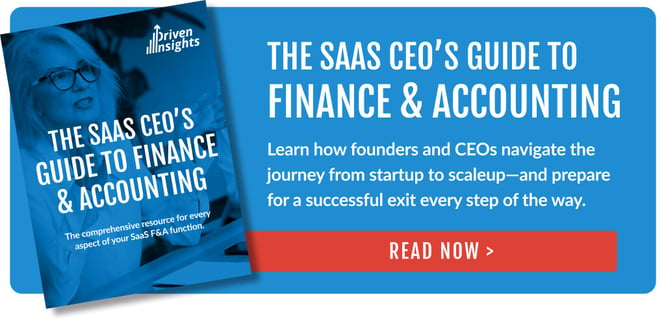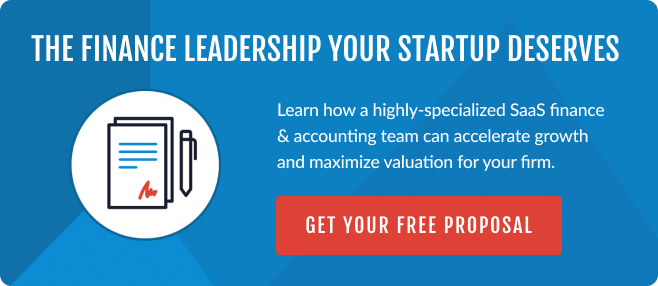
For most SaaS businesses, recurring revenue generated from subscriptions is the primary driver of growth … and of enterprise value. But, while the business model is conceptually simple, the financial reporting and revenue recognition policies behind it can be quite complex. With contracts spread over multiple time periods, varying terms, contract expansion and contraction, terminations and new additions, an assortment of pricing models, variable consideration, and non-recurring charges all added to the mix—the process of accurate revenue recognition is anything but standard.
ASC 606 was designed to manage this complexity, by providing a common framework for recognizing revenue. When a SaaS firm can accurately and consistently identify the period in which revenue was earned, leadership, investors, and other stakeholders have a clear window into the health of the business. When it comes to making informed decisions, this is critical information.
In this article, we’ll explore ASC 606 in detail, and answer the questions SaaS founders and CEOs ask most often:
- What is ASC 606?
- What’s the difference between ASC 605 and ASC 606?
- What are the 5 steps to recognizing revenue with ASC 606?
- Why does the timing of revenue recognition matter?
While revenue recognition and reporting guidelines may be inherently complex topics, we’ll break it down into simple terms, so you know exactly what ASC 606 means for your SaaS company.
What is ASC 606?
Accounting Standards Codification (ASC) 606 is a standard that allows businesses to recognize revenue in a clear and consistent way. While many businesses can recognize revenue under Generally Accepted Accounting Principles, or GAAP when providing goods and services to customers, transactions aren’t as straightforward with the SaaS model. With SaaS, revenue recognition under GAAP can easily lead to inaccuracies and inconsistencies in financial reporting.
The main goals of ASC 606 are to:
- Provide a framework for consistent financial reporting.
- Improve comparative analysis and reporting.
- Make it easier to prepare financial statements.
Created by the Financial Accounting Standards Board (FASB), ASC 606 provides the updated guidance that SaaS businesses need to properly recognize revenue on their financial statements and support overall financial health.
ASC 605 vs. 606: Evolving Standards for SaaS Revenue Recognition
ASC 606 is an update to previous guidelines defined in ASC 605, and came into effect between 2018 and 2019. The aim is to align US-centric GAAP accounting standards with International Financial Reporting Standards (IFRS), creating a stronger and more consistent framework for recognizing revenue across entities, industries, jurisdictions, and capital markets.
While ASC 605 was largely focused on the satisfaction of obligations, ASC 606 concentrates on the transfer of control and how businesses report the nature, amount, and timing of contracts with customers. ASC 606 is more principles-based and introduces more judgment into the revenue recognition process with a 5-step framework.
The sharper focus on contract-led revenue recognition has a significant impact on the subscription model employed by SaaS businesses.
Revenue Recognition is Straightforward for Many Traditional Companies
Under ASC 606, a business can recognize revenue when it has provided specific goods and services for a customer. For many traditional types of businesses, this is a straightforward transaction.
When a customer purchases food from a restaurant, for example, a product and service are delivered and consumed at once. The restaurant would recognize the revenue immediately.
Revenue Recognition is More Complex for SaaS Businesses
Many SaaS business customers prepay for subscription services as part of a contract, but they do not use those services in their entirety at once. In these cases, a SaaS business must not recognize the revenue until the services are consumed.
SaaS contracts are often complex, with multiple pricing structures, engagement terms, and services spread across implementation, subscription, and add ons. Without a clear framework for revenue recognition, this can translate into inaccurate and inconsistent financial reporting—which can lead to a number of problems with compliance, taxation, valuation, and more.
The 5-Step Framework for SaaS Revenue Recognition with ASC 606
ASC 606 outlines 5 steps to recognizing revenue for businesses that enter into contracts to provide goods or services to customers.
Step One: Identify the Contract with a Customer
Review each of your agreements to provide SaaS products and services to customers, so you can understand if it is a contract as defined by ASC 606. The main tests for this are:
- The contract is approved and signed by you as the SaaS provider, and your customer as the party receiving the services.
- Rights to goods and services are clearly defined within the contract.
- Payment terms are clearly defined within the contract and you are likely to be able to collect those payments.
- The contract would pass the commercial substance test.
Step Two: Identify the Performance Obligations in the Contract
Examine your contracts and pricing structures and define where you’ve agreed to provide a specific SaaS product or service to your customers. You’ll want to answer the following questions:
- What are you promising to do or deliver as a seller?
- What is the buyer receiving in exchange for their payment?
- Is the product or service “distinct?” Can the customer benefit from the individual product or service by itself, and is the product or service separately identified within the contract?
This will often mean creating a clear and specific pricing structure and product list within the contract and clearly identifying what will be provided to the customer for each individual item.
Step Three: Determine the Transaction Price
Define exactly how much a customer is going to pay for the services you provide to them:
- Use your contractual price list and terms and conditions to understand exactly what the customer will pay.
- Make sure you consider all variables such as volume pricing, performance bonuses, incentives, and discounts.
- Figure in any refund liabilities you may have.
- Take account of significant financing components and any considerations you’re paying back to the customer.
Of course, it’s possible that your SaaS contracts are simple and straightforward. Some of these areas may not be relevant to your customer agreements.
Step Four: Allocate the Transaction Price
Now that you have defined the products and services you’re providing, and how much the customer will pay, you can accurately allocate these transaction prices:
- You will need to assign the contract transaction value to each obligation you have.
- If you only have one obligation, this will be simple and straightforward.
- If you have more than one obligation:
- You need to allocate each transaction price separately.
- You will use each obligation’s Standalone Selling Price (SSP), this is the price your customer is charged for a specific good or service.
- Typically, discounts also need to be proportionally applied amongst your obligations using the SSP.
Step Five: Recognize Revenue When (or as) the Entity Satisfies a Performance Obligation
Now that you know exactly what revenue you’re capturing, you need to recognize it at the right time:
- Your SaaS business can only recognize revenue as you transfer your goods and services to your customer.
- Much of this is centered around the idea of a “transfer of control.” This is especially relevant for SaaS businesses with long implementation times, as a buyer must be able to actually use your SaaS product for you to recognize that revenue.
- If you meet your performance obligation and deliver a product or service at a specific point in time, that’s when you can recognize that revenue.
- If you meet performance obligations and provide services over a period of time, then you would recognize revenue over that period.
Why the Timing of SaaS Revenue Recognition Matters
By understanding how to record revenue as you meet contractual commitments, you will have an accurate measurement of both your distinct performance obligations and pending customer obligations.
With this insight, you can ensure revenue recognition only occurs after all contractual commitments have been satisfied. And, it will also help to align the costs of delivering products and services with the timing of revenue.
Proper timing of revenue recognition is not only essential to a robust SaaS finance and accounting function, it will help investors and external parties to understand your revenue cycle and properly evaluate your business.
How You Can Ensure Proper SaaS Revenue Recognition
When it comes to SaaS finance and accounting, consistent practices and systems are critical. By helping to transform complex revenue recognition from a convoluted and inconsistent process into a universally accepted methodology, ASC 606 provides a valuable framework for SaaS businesses—but there is still plenty of nuance.
So, what’s the best way to ensure proper revenue recognition? With an outsourced CFO service for SaaS companies, firms at every stage of growth can harness the expertise of high-level financial leadership and a complete finance and accounting team that understands complex contract obligations and how to implement ASC 606 standards.
And, that’s just the beginning. With consistent, accurate, timely financial reporting, you’ll be able to leverage data to make the right decisions, manage stakeholders, attract investors, and maximize valuation with confidence.
Learn more by scheduling your introduction to Driven Insights today. You’ll receive a free proposal and discover a cost-effective way to have all the finance resources your business deserves, today and as you grow.








